BSc Business Management: Financial Performance Analysis - BMP3005
VerifiedAdded on 2023/06/18
|14
|3753
|254
Report
AI Summary
This report provides a comprehensive analysis of financial management concepts and their importance in enhancing business performance. It delves into the main financial statements, including the balance sheet, income statement, cash flow statement, and statement of change in equity, explaining the use of ratios in financial management. The report includes a business review template, an income statement, and a balance sheet for a sample organization, along with a description of the company's profitability, liquidity, and efficiency based on ratio analysis. Furthermore, it explores various processes businesses can employ to improve their financial performance, drawing examples from the case study. The analysis emphasizes the role of financial planning, safeguarding funds, proper utilization of resources, and sound financial decision-making in achieving organizational goals and maximizing stakeholder value. This document is available on Desklib, where students can find a wide array of past papers and solved assignments.
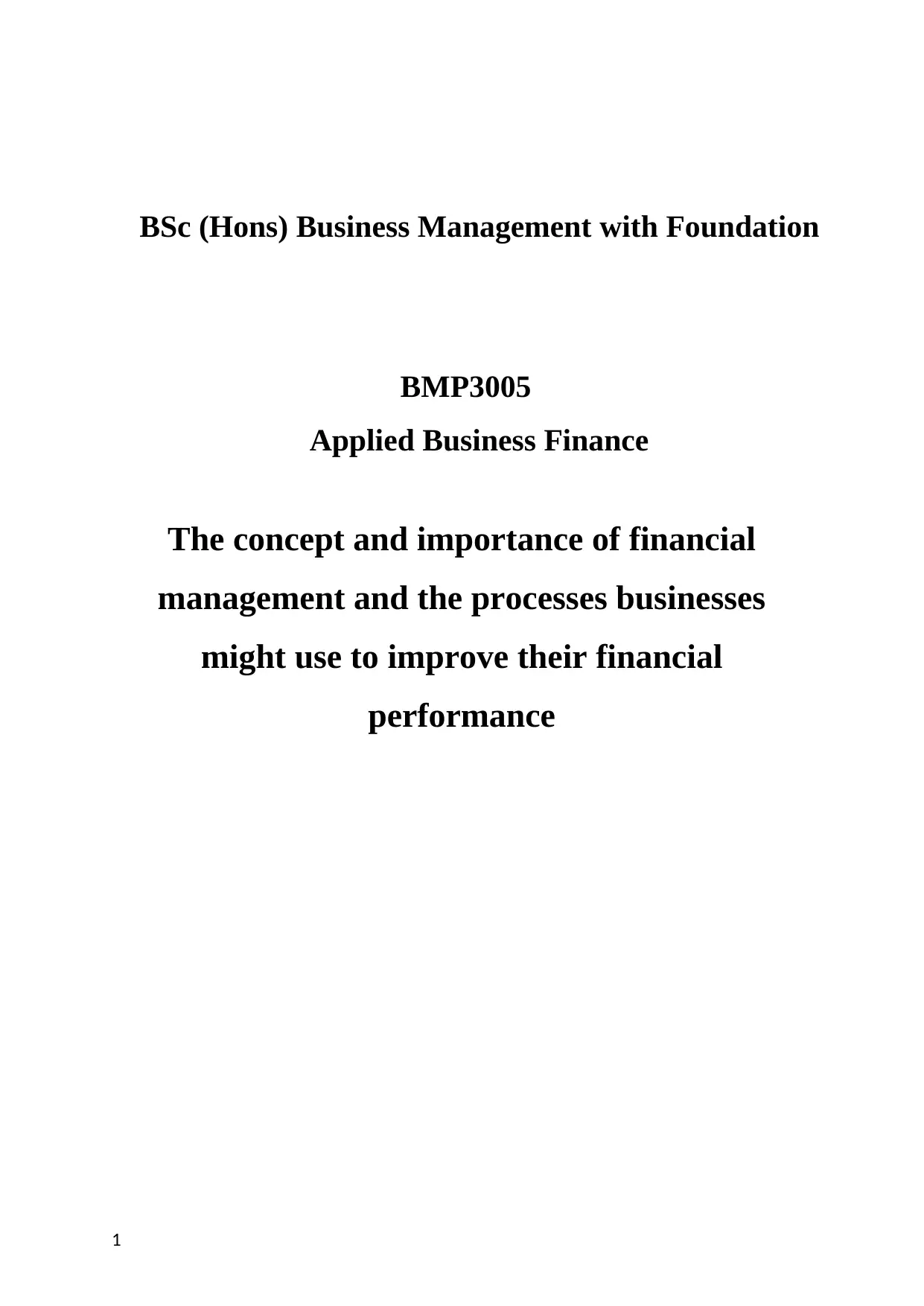
BSc (Hons) Business Management with Foundation
BMP3005
Applied Business Finance
The concept and importance of financial
management and the processes businesses
might use to improve their financial
performance
1
BMP3005
Applied Business Finance
The concept and importance of financial
management and the processes businesses
might use to improve their financial
performance
1
Paraphrase This Document
Need a fresh take? Get an instant paraphrase of this document with our AI Paraphraser
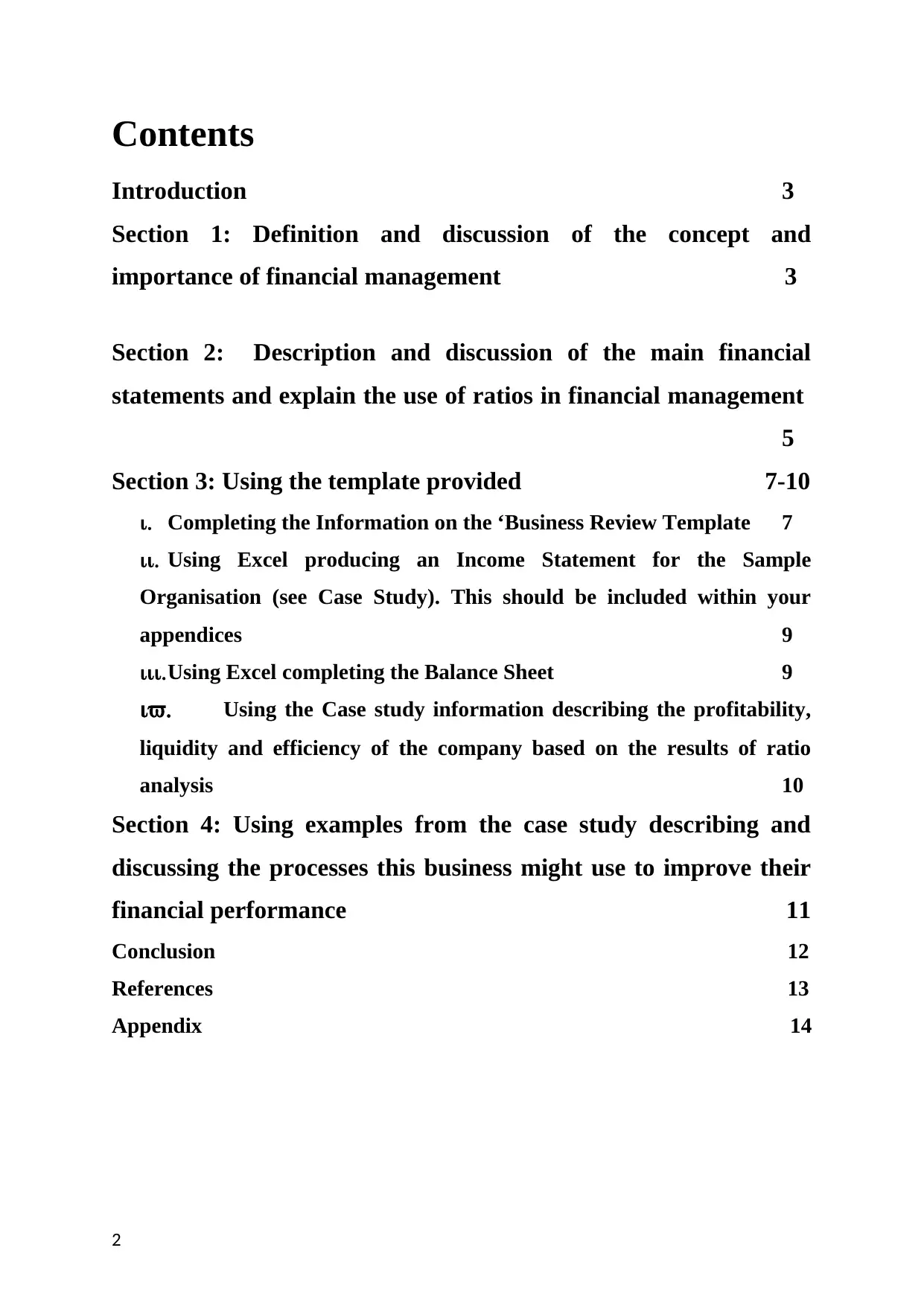
Contents
Introduction 3
Section 1: Definition and discussion of the concept and
importance of financial management 3
Section 2: Description and discussion of the main financial
statements and explain the use of ratios in financial management
5
Section 3: Using the template provided 7-10
i. Completing the Information on the ‘Business Review Template 7
ii. Using Excel producing an Income Statement for the Sample
Organisation (see Case Study). This should be included within your
appendices 9
iii.Using Excel completing the Balance Sheet 9
iv. Using the Case study information describing the profitability,
liquidity and efficiency of the company based on the results of ratio
analysis 10
Section 4: Using examples from the case study describing and
discussing the processes this business might use to improve their
financial performance 11
Conclusion 12
References 13
Appendix 14
2
Introduction 3
Section 1: Definition and discussion of the concept and
importance of financial management 3
Section 2: Description and discussion of the main financial
statements and explain the use of ratios in financial management
5
Section 3: Using the template provided 7-10
i. Completing the Information on the ‘Business Review Template 7
ii. Using Excel producing an Income Statement for the Sample
Organisation (see Case Study). This should be included within your
appendices 9
iii.Using Excel completing the Balance Sheet 9
iv. Using the Case study information describing the profitability,
liquidity and efficiency of the company based on the results of ratio
analysis 10
Section 4: Using examples from the case study describing and
discussing the processes this business might use to improve their
financial performance 11
Conclusion 12
References 13
Appendix 14
2
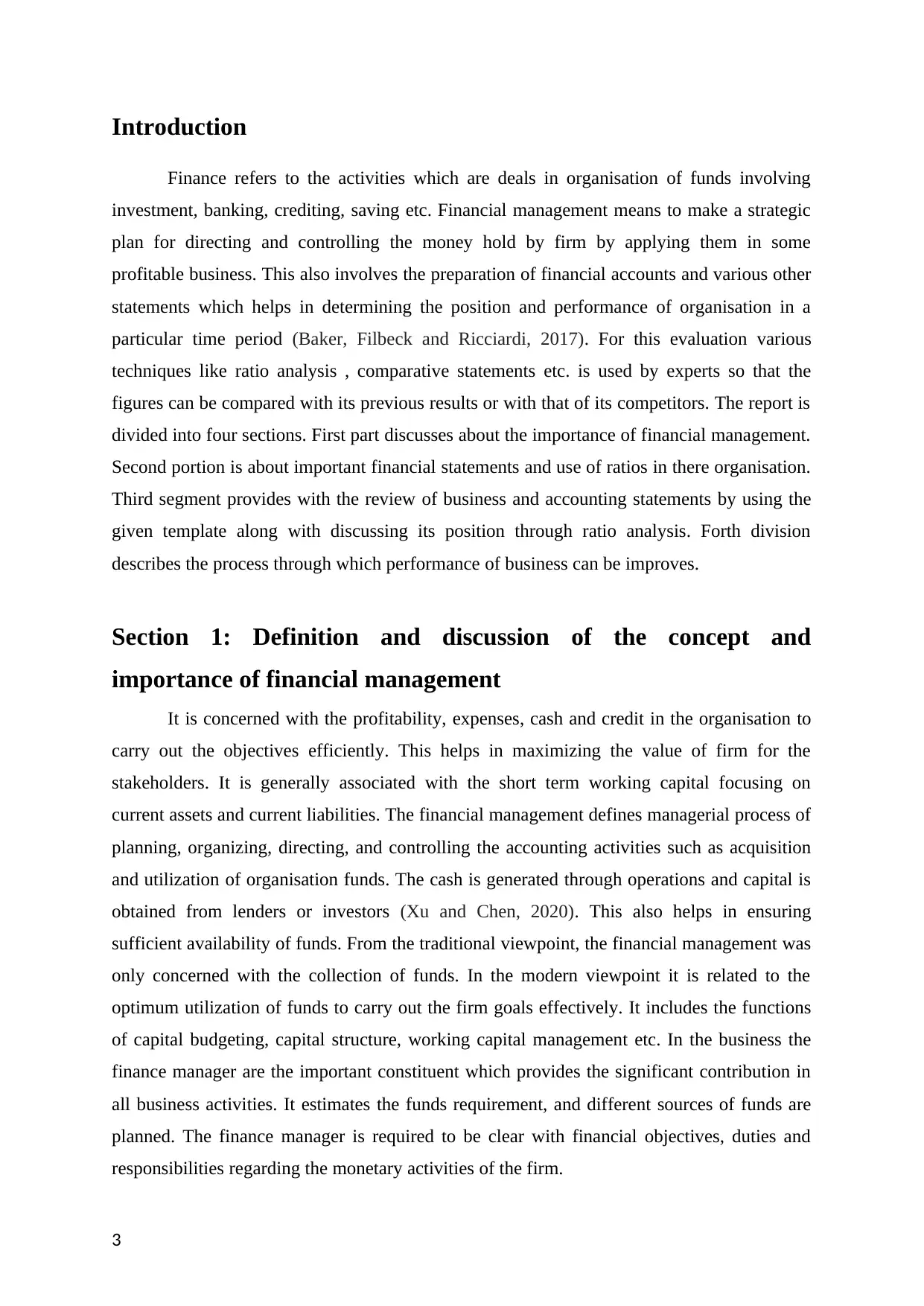
Introduction
Finance refers to the activities which are deals in organisation of funds involving
investment, banking, crediting, saving etc. Financial management means to make a strategic
plan for directing and controlling the money hold by firm by applying them in some
profitable business. This also involves the preparation of financial accounts and various other
statements which helps in determining the position and performance of organisation in a
particular time period (Baker, Filbeck and Ricciardi, 2017). For this evaluation various
techniques like ratio analysis , comparative statements etc. is used by experts so that the
figures can be compared with its previous results or with that of its competitors. The report is
divided into four sections. First part discusses about the importance of financial management.
Second portion is about important financial statements and use of ratios in there organisation.
Third segment provides with the review of business and accounting statements by using the
given template along with discussing its position through ratio analysis. Forth division
describes the process through which performance of business can be improves.
Section 1: Definition and discussion of the concept and
importance of financial management
It is concerned with the profitability, expenses, cash and credit in the organisation to
carry out the objectives efficiently. This helps in maximizing the value of firm for the
stakeholders. It is generally associated with the short term working capital focusing on
current assets and current liabilities. The financial management defines managerial process of
planning, organizing, directing, and controlling the accounting activities such as acquisition
and utilization of organisation funds. The cash is generated through operations and capital is
obtained from lenders or investors (Xu and Chen, 2020). This also helps in ensuring
sufficient availability of funds. From the traditional viewpoint, the financial management was
only concerned with the collection of funds. In the modern viewpoint it is related to the
optimum utilization of funds to carry out the firm goals effectively. It includes the functions
of capital budgeting, capital structure, working capital management etc. In the business the
finance manager are the important constituent which provides the significant contribution in
all business activities. It estimates the funds requirement, and different sources of funds are
planned. The finance manager is required to be clear with financial objectives, duties and
responsibilities regarding the monetary activities of the firm.
3
Finance refers to the activities which are deals in organisation of funds involving
investment, banking, crediting, saving etc. Financial management means to make a strategic
plan for directing and controlling the money hold by firm by applying them in some
profitable business. This also involves the preparation of financial accounts and various other
statements which helps in determining the position and performance of organisation in a
particular time period (Baker, Filbeck and Ricciardi, 2017). For this evaluation various
techniques like ratio analysis , comparative statements etc. is used by experts so that the
figures can be compared with its previous results or with that of its competitors. The report is
divided into four sections. First part discusses about the importance of financial management.
Second portion is about important financial statements and use of ratios in there organisation.
Third segment provides with the review of business and accounting statements by using the
given template along with discussing its position through ratio analysis. Forth division
describes the process through which performance of business can be improves.
Section 1: Definition and discussion of the concept and
importance of financial management
It is concerned with the profitability, expenses, cash and credit in the organisation to
carry out the objectives efficiently. This helps in maximizing the value of firm for the
stakeholders. It is generally associated with the short term working capital focusing on
current assets and current liabilities. The financial management defines managerial process of
planning, organizing, directing, and controlling the accounting activities such as acquisition
and utilization of organisation funds. The cash is generated through operations and capital is
obtained from lenders or investors (Xu and Chen, 2020). This also helps in ensuring
sufficient availability of funds. From the traditional viewpoint, the financial management was
only concerned with the collection of funds. In the modern viewpoint it is related to the
optimum utilization of funds to carry out the firm goals effectively. It includes the functions
of capital budgeting, capital structure, working capital management etc. In the business the
finance manager are the important constituent which provides the significant contribution in
all business activities. It estimates the funds requirement, and different sources of funds are
planned. The finance manager is required to be clear with financial objectives, duties and
responsibilities regarding the monetary activities of the firm.
3
⊘ This is a preview!⊘
Do you want full access?
Subscribe today to unlock all pages.

Trusted by 1+ million students worldwide
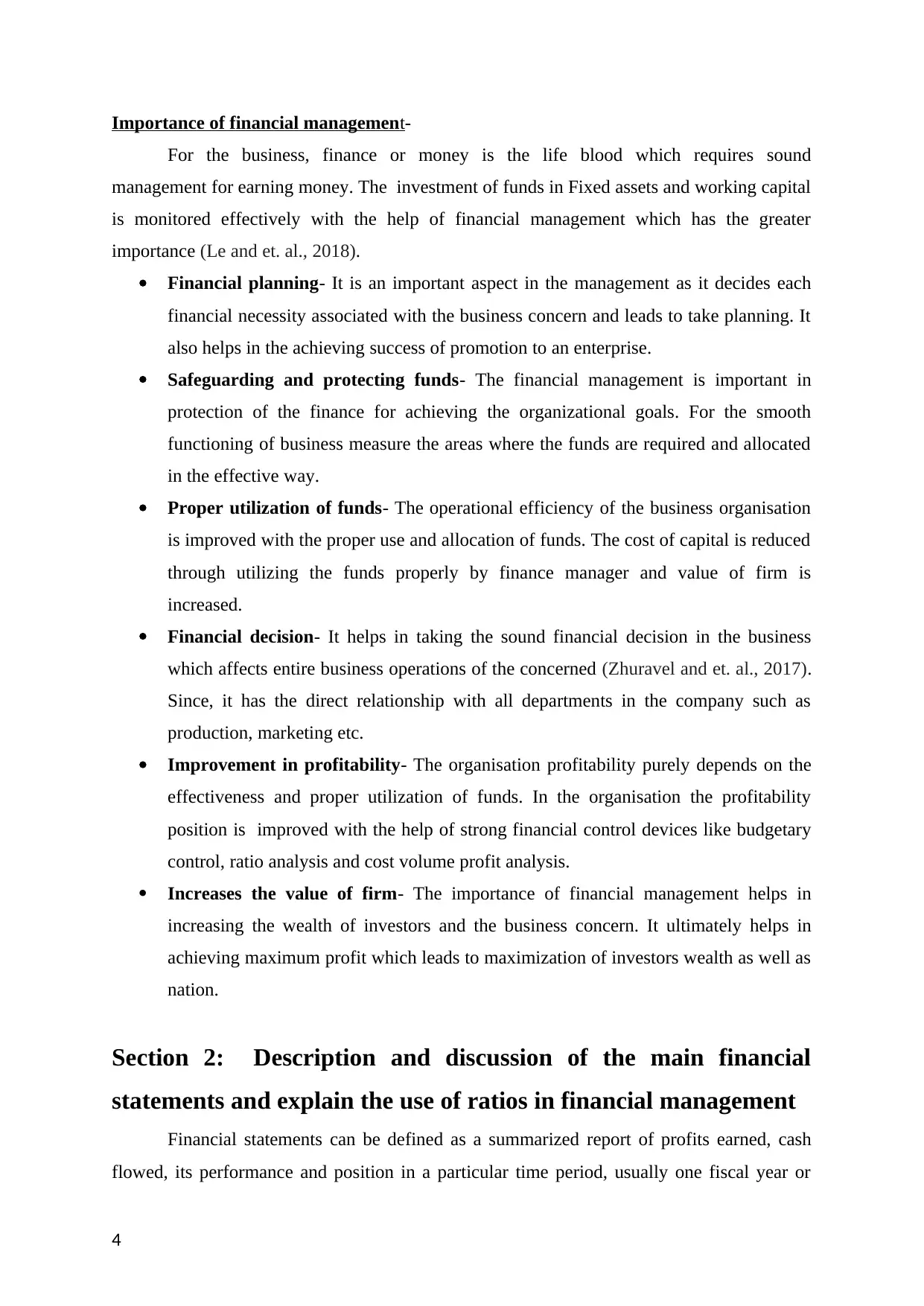
Importance of financial management-
For the business, finance or money is the life blood which requires sound
management for earning money. The investment of funds in Fixed assets and working capital
is monitored effectively with the help of financial management which has the greater
importance (Le and et. al., 2018).
Financial planning- It is an important aspect in the management as it decides each
financial necessity associated with the business concern and leads to take planning. It
also helps in the achieving success of promotion to an enterprise.
Safeguarding and protecting funds- The financial management is important in
protection of the finance for achieving the organizational goals. For the smooth
functioning of business measure the areas where the funds are required and allocated
in the effective way.
Proper utilization of funds- The operational efficiency of the business organisation
is improved with the proper use and allocation of funds. The cost of capital is reduced
through utilizing the funds properly by finance manager and value of firm is
increased.
Financial decision- It helps in taking the sound financial decision in the business
which affects entire business operations of the concerned (Zhuravel and et. al., 2017).
Since, it has the direct relationship with all departments in the company such as
production, marketing etc.
Improvement in profitability- The organisation profitability purely depends on the
effectiveness and proper utilization of funds. In the organisation the profitability
position is improved with the help of strong financial control devices like budgetary
control, ratio analysis and cost volume profit analysis.
Increases the value of firm- The importance of financial management helps in
increasing the wealth of investors and the business concern. It ultimately helps in
achieving maximum profit which leads to maximization of investors wealth as well as
nation.
Section 2: Description and discussion of the main financial
statements and explain the use of ratios in financial management
Financial statements can be defined as a summarized report of profits earned, cash
flowed, its performance and position in a particular time period, usually one fiscal year or
4
For the business, finance or money is the life blood which requires sound
management for earning money. The investment of funds in Fixed assets and working capital
is monitored effectively with the help of financial management which has the greater
importance (Le and et. al., 2018).
Financial planning- It is an important aspect in the management as it decides each
financial necessity associated with the business concern and leads to take planning. It
also helps in the achieving success of promotion to an enterprise.
Safeguarding and protecting funds- The financial management is important in
protection of the finance for achieving the organizational goals. For the smooth
functioning of business measure the areas where the funds are required and allocated
in the effective way.
Proper utilization of funds- The operational efficiency of the business organisation
is improved with the proper use and allocation of funds. The cost of capital is reduced
through utilizing the funds properly by finance manager and value of firm is
increased.
Financial decision- It helps in taking the sound financial decision in the business
which affects entire business operations of the concerned (Zhuravel and et. al., 2017).
Since, it has the direct relationship with all departments in the company such as
production, marketing etc.
Improvement in profitability- The organisation profitability purely depends on the
effectiveness and proper utilization of funds. In the organisation the profitability
position is improved with the help of strong financial control devices like budgetary
control, ratio analysis and cost volume profit analysis.
Increases the value of firm- The importance of financial management helps in
increasing the wealth of investors and the business concern. It ultimately helps in
achieving maximum profit which leads to maximization of investors wealth as well as
nation.
Section 2: Description and discussion of the main financial
statements and explain the use of ratios in financial management
Financial statements can be defined as a summarized report of profits earned, cash
flowed, its performance and position in a particular time period, usually one fiscal year or
4
Paraphrase This Document
Need a fresh take? Get an instant paraphrase of this document with our AI Paraphraser
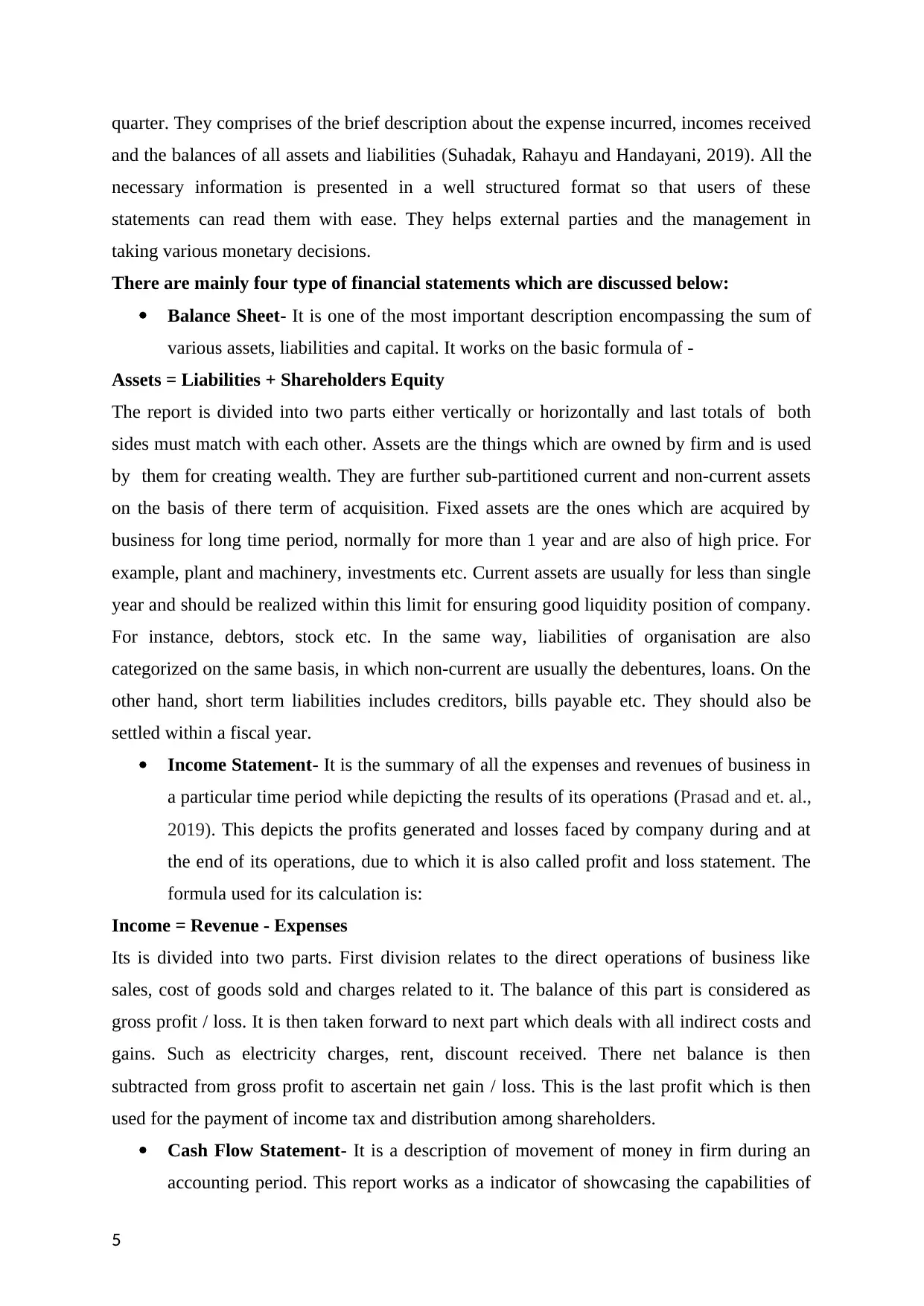
quarter. They comprises of the brief description about the expense incurred, incomes received
and the balances of all assets and liabilities (Suhadak, Rahayu and Handayani, 2019). All the
necessary information is presented in a well structured format so that users of these
statements can read them with ease. They helps external parties and the management in
taking various monetary decisions.
There are mainly four type of financial statements which are discussed below:
Balance Sheet- It is one of the most important description encompassing the sum of
various assets, liabilities and capital. It works on the basic formula of -
Assets = Liabilities + Shareholders Equity
The report is divided into two parts either vertically or horizontally and last totals of both
sides must match with each other. Assets are the things which are owned by firm and is used
by them for creating wealth. They are further sub-partitioned current and non-current assets
on the basis of there term of acquisition. Fixed assets are the ones which are acquired by
business for long time period, normally for more than 1 year and are also of high price. For
example, plant and machinery, investments etc. Current assets are usually for less than single
year and should be realized within this limit for ensuring good liquidity position of company.
For instance, debtors, stock etc. In the same way, liabilities of organisation are also
categorized on the same basis, in which non-current are usually the debentures, loans. On the
other hand, short term liabilities includes creditors, bills payable etc. They should also be
settled within a fiscal year.
Income Statement- It is the summary of all the expenses and revenues of business in
a particular time period while depicting the results of its operations (Prasad and et. al.,
2019). This depicts the profits generated and losses faced by company during and at
the end of its operations, due to which it is also called profit and loss statement. The
formula used for its calculation is:
Income = Revenue - Expenses
Its is divided into two parts. First division relates to the direct operations of business like
sales, cost of goods sold and charges related to it. The balance of this part is considered as
gross profit / loss. It is then taken forward to next part which deals with all indirect costs and
gains. Such as electricity charges, rent, discount received. There net balance is then
subtracted from gross profit to ascertain net gain / loss. This is the last profit which is then
used for the payment of income tax and distribution among shareholders.
Cash Flow Statement- It is a description of movement of money in firm during an
accounting period. This report works as a indicator of showcasing the capabilities of
5
and the balances of all assets and liabilities (Suhadak, Rahayu and Handayani, 2019). All the
necessary information is presented in a well structured format so that users of these
statements can read them with ease. They helps external parties and the management in
taking various monetary decisions.
There are mainly four type of financial statements which are discussed below:
Balance Sheet- It is one of the most important description encompassing the sum of
various assets, liabilities and capital. It works on the basic formula of -
Assets = Liabilities + Shareholders Equity
The report is divided into two parts either vertically or horizontally and last totals of both
sides must match with each other. Assets are the things which are owned by firm and is used
by them for creating wealth. They are further sub-partitioned current and non-current assets
on the basis of there term of acquisition. Fixed assets are the ones which are acquired by
business for long time period, normally for more than 1 year and are also of high price. For
example, plant and machinery, investments etc. Current assets are usually for less than single
year and should be realized within this limit for ensuring good liquidity position of company.
For instance, debtors, stock etc. In the same way, liabilities of organisation are also
categorized on the same basis, in which non-current are usually the debentures, loans. On the
other hand, short term liabilities includes creditors, bills payable etc. They should also be
settled within a fiscal year.
Income Statement- It is the summary of all the expenses and revenues of business in
a particular time period while depicting the results of its operations (Prasad and et. al.,
2019). This depicts the profits generated and losses faced by company during and at
the end of its operations, due to which it is also called profit and loss statement. The
formula used for its calculation is:
Income = Revenue - Expenses
Its is divided into two parts. First division relates to the direct operations of business like
sales, cost of goods sold and charges related to it. The balance of this part is considered as
gross profit / loss. It is then taken forward to next part which deals with all indirect costs and
gains. Such as electricity charges, rent, discount received. There net balance is then
subtracted from gross profit to ascertain net gain / loss. This is the last profit which is then
used for the payment of income tax and distribution among shareholders.
Cash Flow Statement- It is a description of movement of money in firm during an
accounting period. This report works as a indicator of showcasing the capabilities of
5
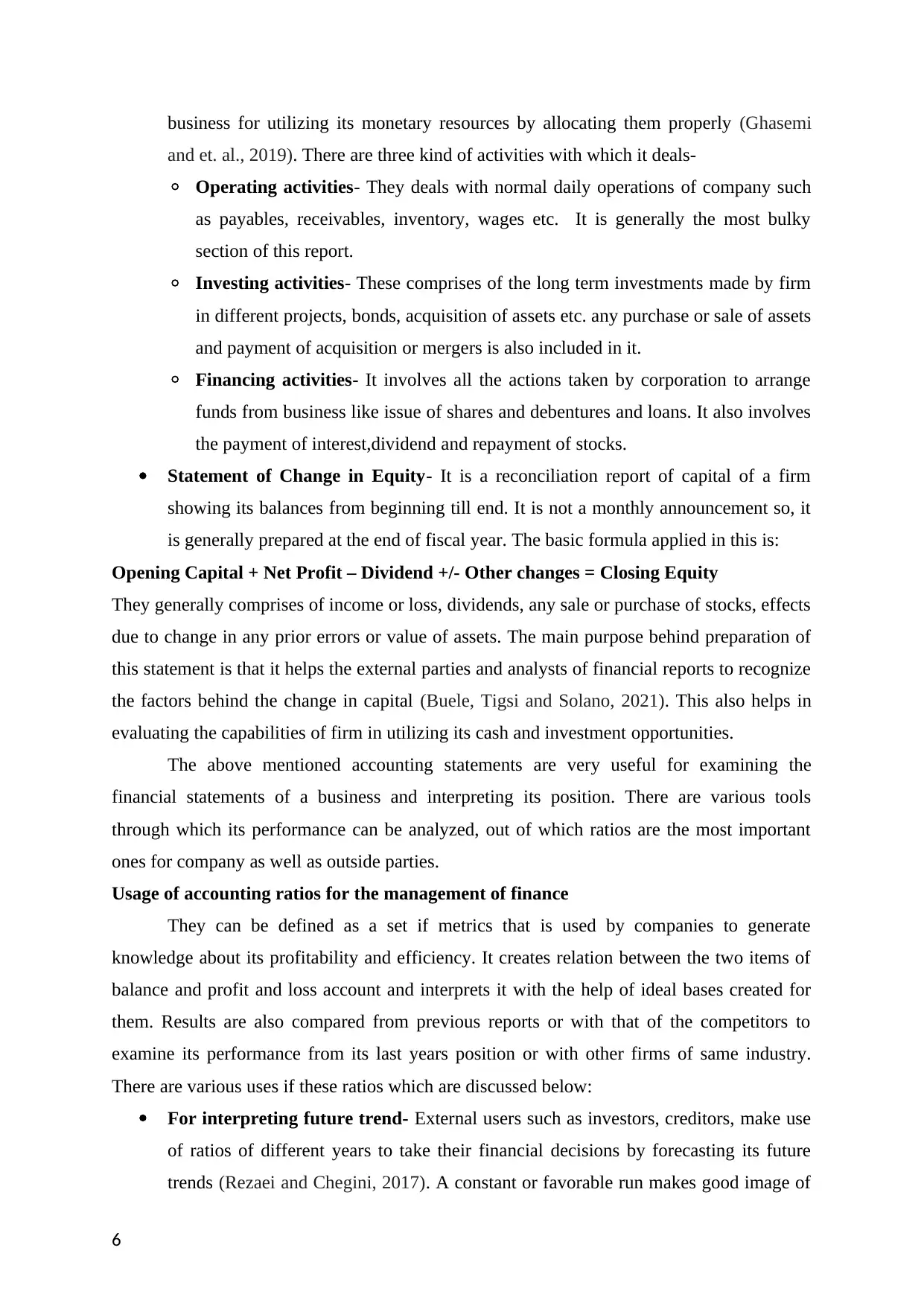
business for utilizing its monetary resources by allocating them properly (Ghasemi
and et. al., 2019). There are three kind of activities with which it deals-
◦ Operating activities- They deals with normal daily operations of company such
as payables, receivables, inventory, wages etc. It is generally the most bulky
section of this report.
◦ Investing activities- These comprises of the long term investments made by firm
in different projects, bonds, acquisition of assets etc. any purchase or sale of assets
and payment of acquisition or mergers is also included in it.
◦ Financing activities- It involves all the actions taken by corporation to arrange
funds from business like issue of shares and debentures and loans. It also involves
the payment of interest,dividend and repayment of stocks.
Statement of Change in Equity- It is a reconciliation report of capital of a firm
showing its balances from beginning till end. It is not a monthly announcement so, it
is generally prepared at the end of fiscal year. The basic formula applied in this is:
Opening Capital + Net Profit – Dividend +/- Other changes = Closing Equity
They generally comprises of income or loss, dividends, any sale or purchase of stocks, effects
due to change in any prior errors or value of assets. The main purpose behind preparation of
this statement is that it helps the external parties and analysts of financial reports to recognize
the factors behind the change in capital (Buele, Tigsi and Solano, 2021). This also helps in
evaluating the capabilities of firm in utilizing its cash and investment opportunities.
The above mentioned accounting statements are very useful for examining the
financial statements of a business and interpreting its position. There are various tools
through which its performance can be analyzed, out of which ratios are the most important
ones for company as well as outside parties.
Usage of accounting ratios for the management of finance
They can be defined as a set if metrics that is used by companies to generate
knowledge about its profitability and efficiency. It creates relation between the two items of
balance and profit and loss account and interprets it with the help of ideal bases created for
them. Results are also compared from previous reports or with that of the competitors to
examine its performance from its last years position or with other firms of same industry.
There are various uses if these ratios which are discussed below:
For interpreting future trend- External users such as investors, creditors, make use
of ratios of different years to take their financial decisions by forecasting its future
trends (Rezaei and Chegini, 2017). A constant or favorable run makes good image of
6
and et. al., 2019). There are three kind of activities with which it deals-
◦ Operating activities- They deals with normal daily operations of company such
as payables, receivables, inventory, wages etc. It is generally the most bulky
section of this report.
◦ Investing activities- These comprises of the long term investments made by firm
in different projects, bonds, acquisition of assets etc. any purchase or sale of assets
and payment of acquisition or mergers is also included in it.
◦ Financing activities- It involves all the actions taken by corporation to arrange
funds from business like issue of shares and debentures and loans. It also involves
the payment of interest,dividend and repayment of stocks.
Statement of Change in Equity- It is a reconciliation report of capital of a firm
showing its balances from beginning till end. It is not a monthly announcement so, it
is generally prepared at the end of fiscal year. The basic formula applied in this is:
Opening Capital + Net Profit – Dividend +/- Other changes = Closing Equity
They generally comprises of income or loss, dividends, any sale or purchase of stocks, effects
due to change in any prior errors or value of assets. The main purpose behind preparation of
this statement is that it helps the external parties and analysts of financial reports to recognize
the factors behind the change in capital (Buele, Tigsi and Solano, 2021). This also helps in
evaluating the capabilities of firm in utilizing its cash and investment opportunities.
The above mentioned accounting statements are very useful for examining the
financial statements of a business and interpreting its position. There are various tools
through which its performance can be analyzed, out of which ratios are the most important
ones for company as well as outside parties.
Usage of accounting ratios for the management of finance
They can be defined as a set if metrics that is used by companies to generate
knowledge about its profitability and efficiency. It creates relation between the two items of
balance and profit and loss account and interprets it with the help of ideal bases created for
them. Results are also compared from previous reports or with that of the competitors to
examine its performance from its last years position or with other firms of same industry.
There are various uses if these ratios which are discussed below:
For interpreting future trend- External users such as investors, creditors, make use
of ratios of different years to take their financial decisions by forecasting its future
trends (Rezaei and Chegini, 2017). A constant or favorable run makes good image of
6
⊘ This is a preview!⊘
Do you want full access?
Subscribe today to unlock all pages.

Trusted by 1+ million students worldwide
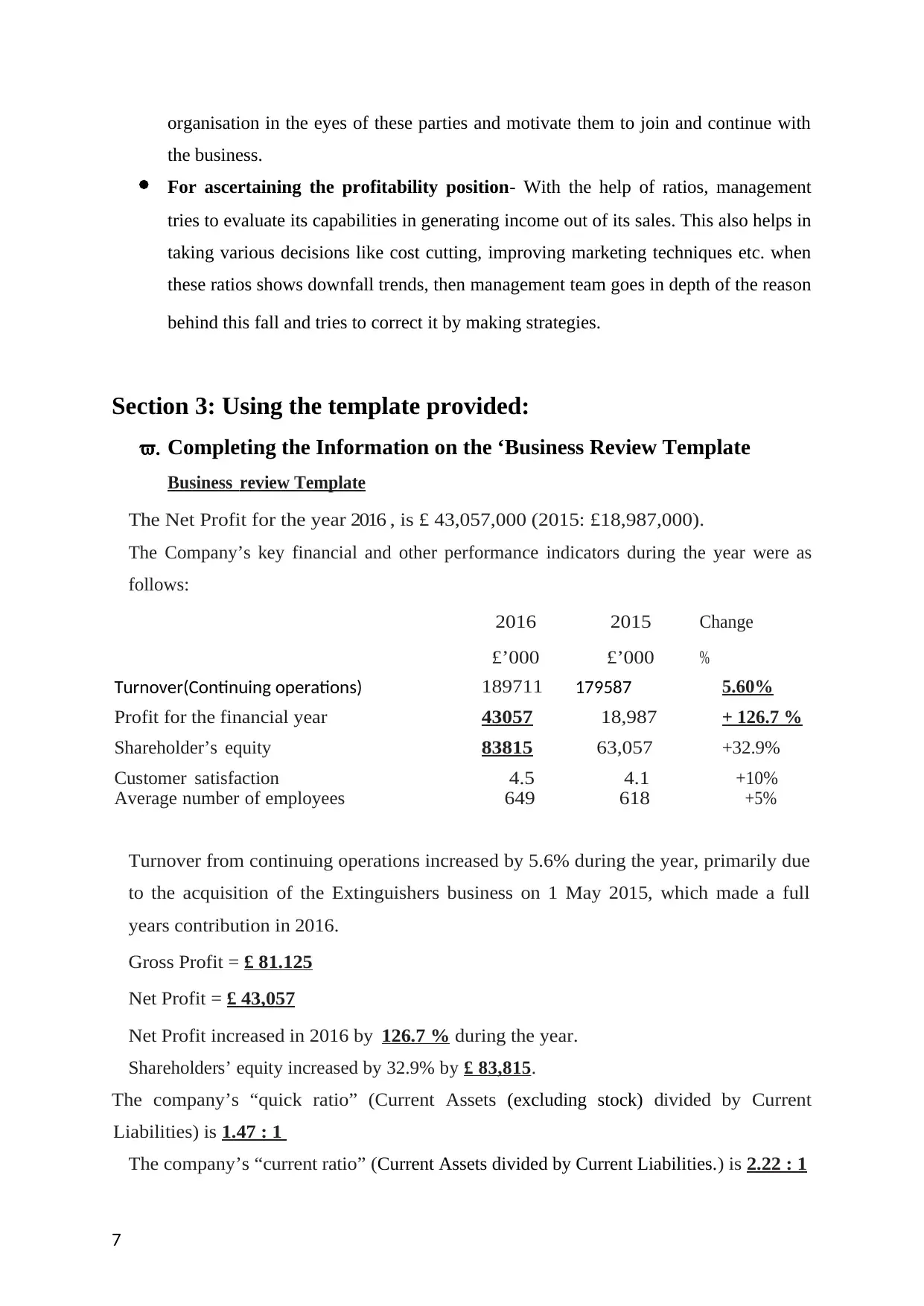
organisation in the eyes of these parties and motivate them to join and continue with
the business.
For ascertaining the profitability position- With the help of ratios, management
tries to evaluate its capabilities in generating income out of its sales. This also helps in
taking various decisions like cost cutting, improving marketing techniques etc. when
these ratios shows downfall trends, then management team goes in depth of the reason
behind this fall and tries to correct it by making strategies.
Section 3: Using the template provided:
v. Completing the Information on the ‘Business Review Template
Business review Template
The Net Profit for the year 2016 , is £ 43,057,000 (2015: £18,987,000).
The Company’s key financial and other performance indicators during the year were as
follows:
2016
£’000
2015
£’000
Change
%
Turnover(Continuing operations) 189711 179587 5.60%
Profit for the financial year 43057 18,987 + 126.7 %
Shareholder’s equity 83815 63,057 +32.9%
Customer satisfaction 4.5 4.1 +10%
Average number of employees 649 618 +5%
Turnover from continuing operations increased by 5.6% during the year, primarily due
to the acquisition of the Extinguishers business on 1 May 2015, which made a full
years contribution in 2016.
Gross Profit = £ 81.125
Net Profit = £ 43,057
Net Profit increased in 2016 by 126.7 % during the year.
Shareholders’ equity increased by 32.9% by £ 83,815.
The company’s “quick ratio” (Current Assets (excluding stock) divided by Current
Liabilities) is 1.47 : 1
The company’s “current ratio” (Current Assets divided by Current Liabilities. ) is 2.22 : 1
7
the business.
For ascertaining the profitability position- With the help of ratios, management
tries to evaluate its capabilities in generating income out of its sales. This also helps in
taking various decisions like cost cutting, improving marketing techniques etc. when
these ratios shows downfall trends, then management team goes in depth of the reason
behind this fall and tries to correct it by making strategies.
Section 3: Using the template provided:
v. Completing the Information on the ‘Business Review Template
Business review Template
The Net Profit for the year 2016 , is £ 43,057,000 (2015: £18,987,000).
The Company’s key financial and other performance indicators during the year were as
follows:
2016
£’000
2015
£’000
Change
%
Turnover(Continuing operations) 189711 179587 5.60%
Profit for the financial year 43057 18,987 + 126.7 %
Shareholder’s equity 83815 63,057 +32.9%
Customer satisfaction 4.5 4.1 +10%
Average number of employees 649 618 +5%
Turnover from continuing operations increased by 5.6% during the year, primarily due
to the acquisition of the Extinguishers business on 1 May 2015, which made a full
years contribution in 2016.
Gross Profit = £ 81.125
Net Profit = £ 43,057
Net Profit increased in 2016 by 126.7 % during the year.
Shareholders’ equity increased by 32.9% by £ 83,815.
The company’s “quick ratio” (Current Assets (excluding stock) divided by Current
Liabilities) is 1.47 : 1
The company’s “current ratio” (Current Assets divided by Current Liabilities. ) is 2.22 : 1
7
Paraphrase This Document
Need a fresh take? Get an instant paraphrase of this document with our AI Paraphraser
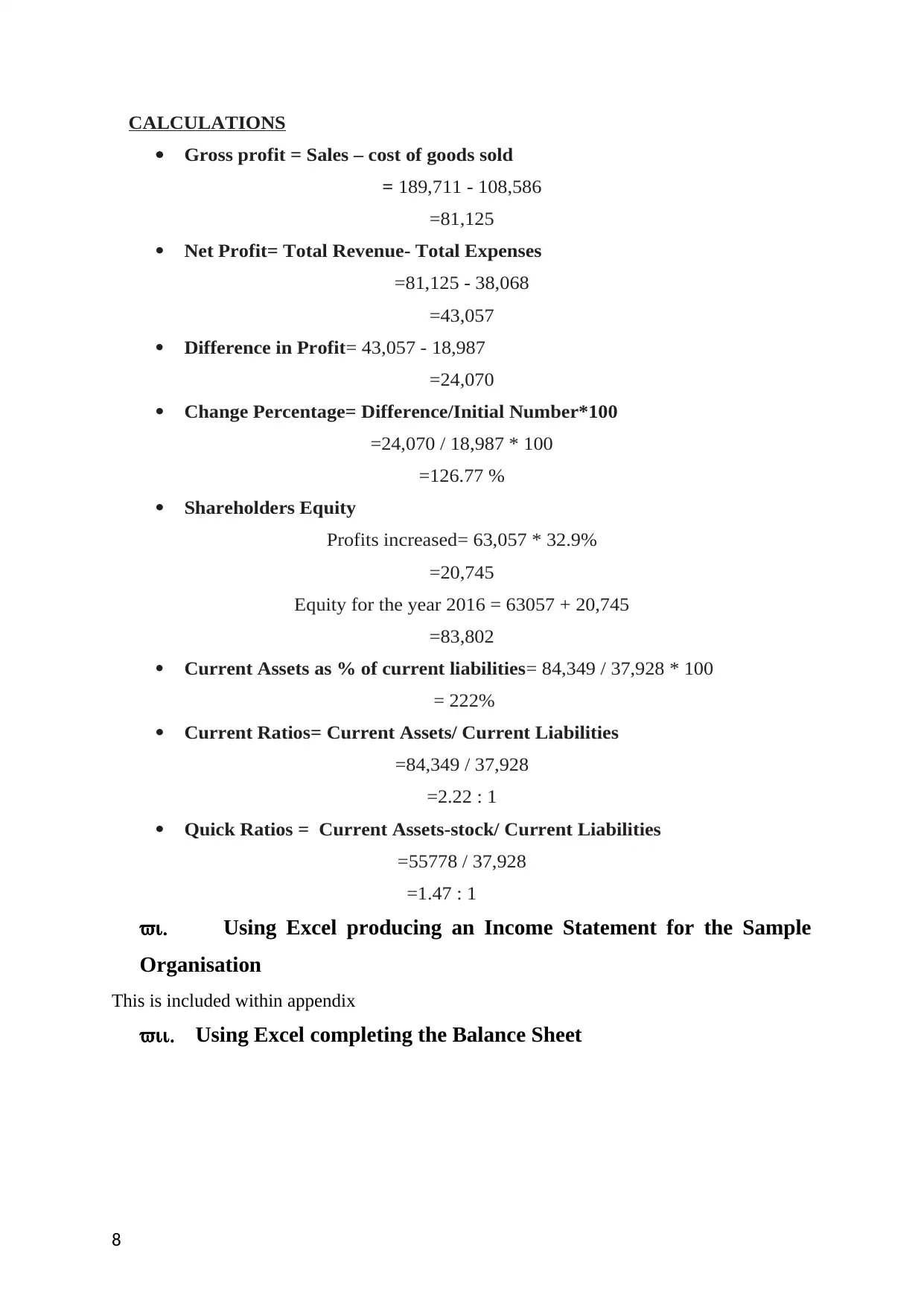
CALCULATIONS
Gross profit = Sales – cost of goods sold
= 189,711 - 108,586
=81,125
Net Profit= Total Revenue- Total Expenses
=81,125 - 38,068
=43,057
Difference in Profit= 43,057 - 18,987
=24,070
Change Percentage= Difference/Initial Number*100
=24,070 / 18,987 * 100
=126.77 %
Shareholders Equity
Profits increased= 63,057 * 32.9%
=20,745
Equity for the year 2016 = 63057 + 20,745
=83,802
Current Assets as % of current liabilities= 84,349 / 37,928 * 100
= 222%
Current Ratios= Current Assets/ Current Liabilities
=84,349 / 37,928
=2.22 : 1
Quick Ratios = Current Assets-stock/ Current Liabilities
=55778 / 37,928
=1.47 : 1
vi. Using Excel producing an Income Statement for the Sample
Organisation
This is included within appendix
vii. Using Excel completing the Balance Sheet
8
Gross profit = Sales – cost of goods sold
= 189,711 - 108,586
=81,125
Net Profit= Total Revenue- Total Expenses
=81,125 - 38,068
=43,057
Difference in Profit= 43,057 - 18,987
=24,070
Change Percentage= Difference/Initial Number*100
=24,070 / 18,987 * 100
=126.77 %
Shareholders Equity
Profits increased= 63,057 * 32.9%
=20,745
Equity for the year 2016 = 63057 + 20,745
=83,802
Current Assets as % of current liabilities= 84,349 / 37,928 * 100
= 222%
Current Ratios= Current Assets/ Current Liabilities
=84,349 / 37,928
=2.22 : 1
Quick Ratios = Current Assets-stock/ Current Liabilities
=55778 / 37,928
=1.47 : 1
vi. Using Excel producing an Income Statement for the Sample
Organisation
This is included within appendix
vii. Using Excel completing the Balance Sheet
8
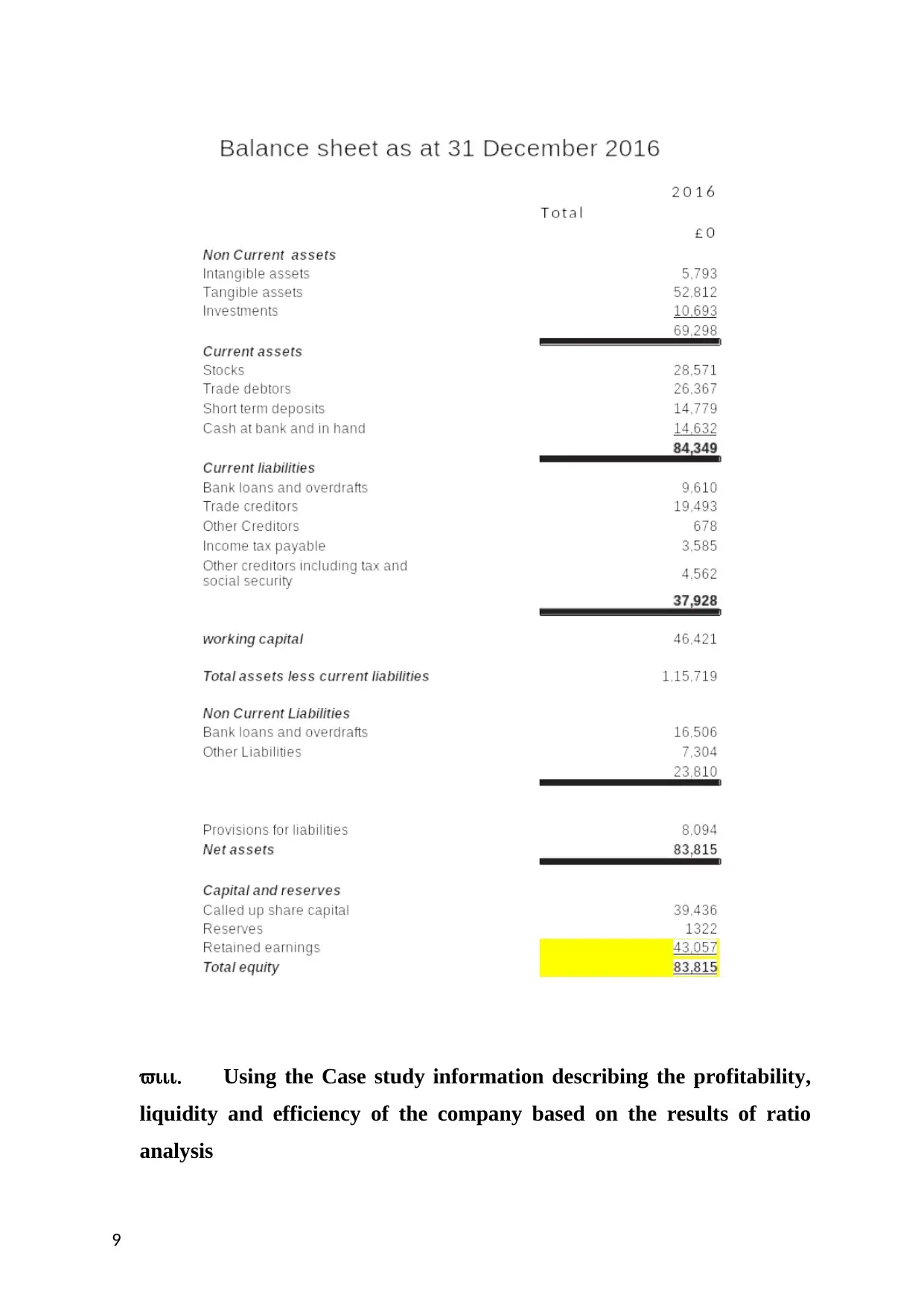
viii. Using the Case study information describing the profitability,
liquidity and efficiency of the company based on the results of ratio
analysis
9
liquidity and efficiency of the company based on the results of ratio
analysis
9
⊘ This is a preview!⊘
Do you want full access?
Subscribe today to unlock all pages.

Trusted by 1+ million students worldwide
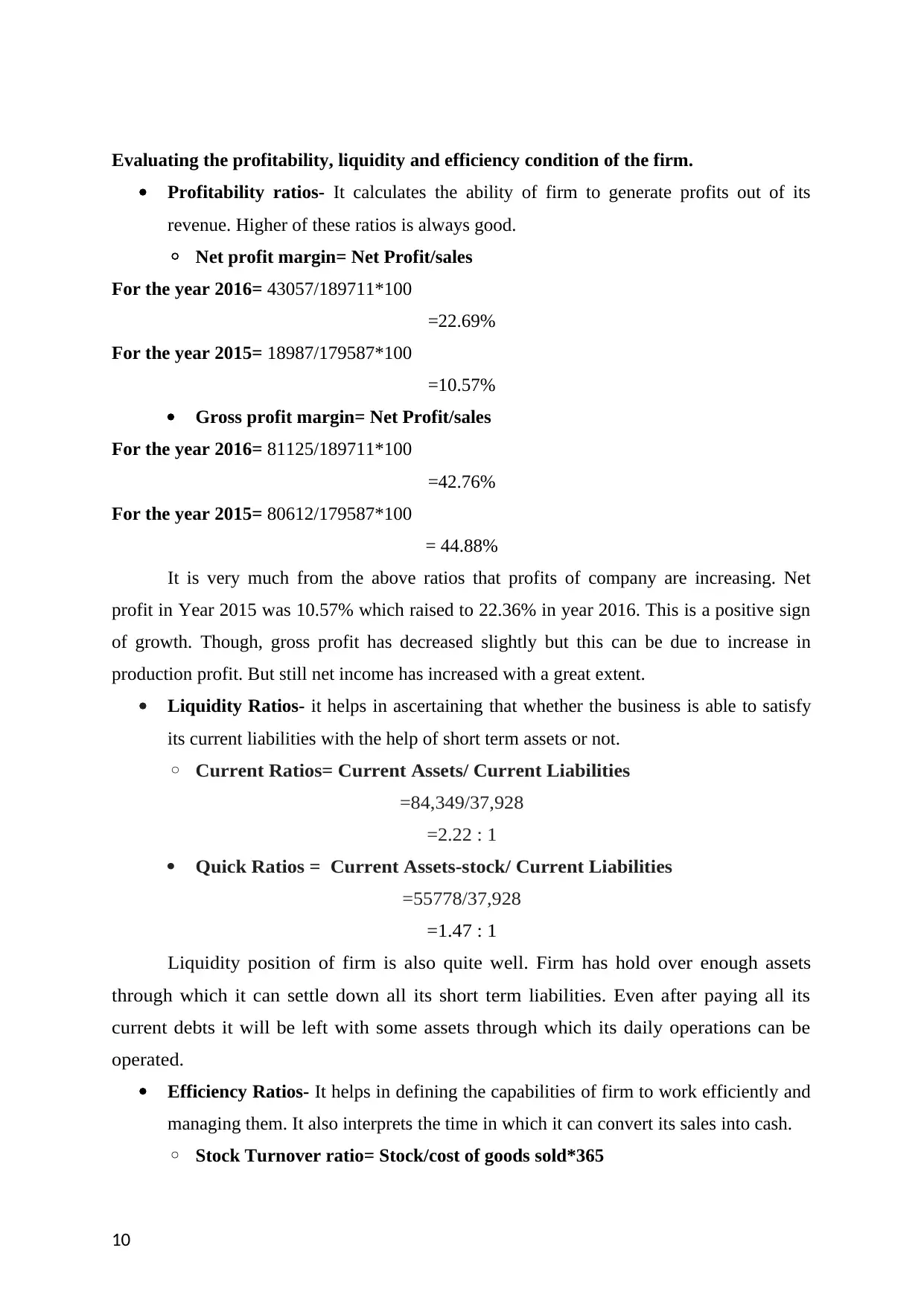
Evaluating the profitability, liquidity and efficiency condition of the firm.
Profitability ratios- It calculates the ability of firm to generate profits out of its
revenue. Higher of these ratios is always good.
◦ Net profit margin= Net Profit/sales
For the year 2016= 43057/189711*100
=22.69%
For the year 2015= 18987/179587*100
=10.57%
Gross profit margin= Net Profit/sales
For the year 2016= 81125/189711*100
=42.76%
For the year 2015= 80612/179587*100
= 44.88%
It is very much from the above ratios that profits of company are increasing. Net
profit in Year 2015 was 10.57% which raised to 22.36% in year 2016. This is a positive sign
of growth. Though, gross profit has decreased slightly but this can be due to increase in
production profit. But still net income has increased with a great extent.
Liquidity Ratios- it helps in ascertaining that whether the business is able to satisfy
its current liabilities with the help of short term assets or not.
◦ Current Ratios= Current Assets/ Current Liabilities
=84,349/37,928
=2.22 : 1
Quick Ratios = Current Assets-stock/ Current Liabilities
=55778/37,928
=1.47 : 1
Liquidity position of firm is also quite well. Firm has hold over enough assets
through which it can settle down all its short term liabilities. Even after paying all its
current debts it will be left with some assets through which its daily operations can be
operated.
Efficiency Ratios- It helps in defining the capabilities of firm to work efficiently and
managing them. It also interprets the time in which it can convert its sales into cash.
◦ Stock Turnover ratio= Stock/cost of goods sold*365
10
Profitability ratios- It calculates the ability of firm to generate profits out of its
revenue. Higher of these ratios is always good.
◦ Net profit margin= Net Profit/sales
For the year 2016= 43057/189711*100
=22.69%
For the year 2015= 18987/179587*100
=10.57%
Gross profit margin= Net Profit/sales
For the year 2016= 81125/189711*100
=42.76%
For the year 2015= 80612/179587*100
= 44.88%
It is very much from the above ratios that profits of company are increasing. Net
profit in Year 2015 was 10.57% which raised to 22.36% in year 2016. This is a positive sign
of growth. Though, gross profit has decreased slightly but this can be due to increase in
production profit. But still net income has increased with a great extent.
Liquidity Ratios- it helps in ascertaining that whether the business is able to satisfy
its current liabilities with the help of short term assets or not.
◦ Current Ratios= Current Assets/ Current Liabilities
=84,349/37,928
=2.22 : 1
Quick Ratios = Current Assets-stock/ Current Liabilities
=55778/37,928
=1.47 : 1
Liquidity position of firm is also quite well. Firm has hold over enough assets
through which it can settle down all its short term liabilities. Even after paying all its
current debts it will be left with some assets through which its daily operations can be
operated.
Efficiency Ratios- It helps in defining the capabilities of firm to work efficiently and
managing them. It also interprets the time in which it can convert its sales into cash.
◦ Stock Turnover ratio= Stock/cost of goods sold*365
10
Paraphrase This Document
Need a fresh take? Get an instant paraphrase of this document with our AI Paraphraser
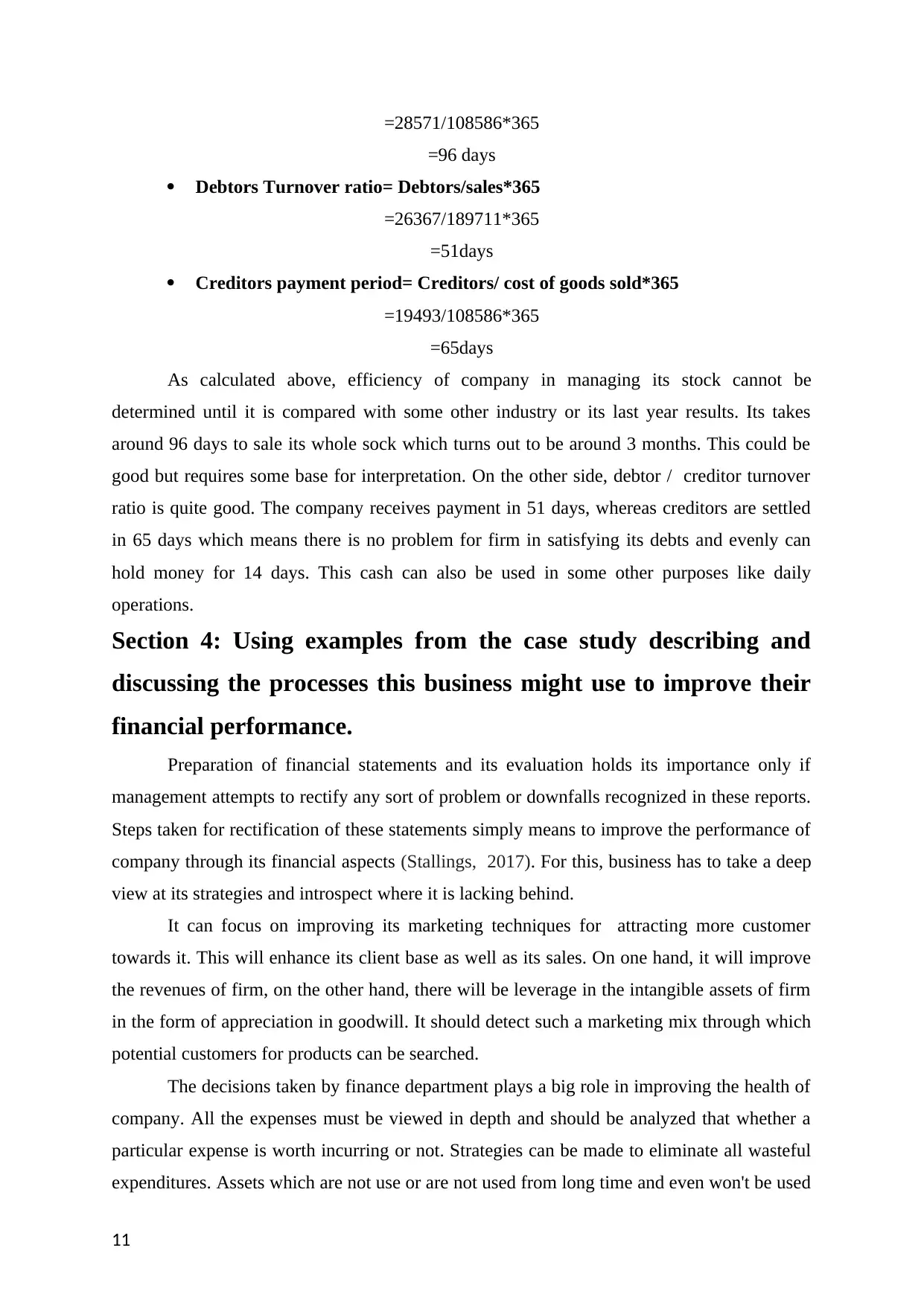
=28571/108586*365
=96 days
Debtors Turnover ratio= Debtors/sales*365
=26367/189711*365
=51days
Creditors payment period= Creditors/ cost of goods sold*365
=19493/108586*365
=65days
As calculated above, efficiency of company in managing its stock cannot be
determined until it is compared with some other industry or its last year results. Its takes
around 96 days to sale its whole sock which turns out to be around 3 months. This could be
good but requires some base for interpretation. On the other side, debtor / creditor turnover
ratio is quite good. The company receives payment in 51 days, whereas creditors are settled
in 65 days which means there is no problem for firm in satisfying its debts and evenly can
hold money for 14 days. This cash can also be used in some other purposes like daily
operations.
Section 4: Using examples from the case study describing and
discussing the processes this business might use to improve their
financial performance.
Preparation of financial statements and its evaluation holds its importance only if
management attempts to rectify any sort of problem or downfalls recognized in these reports.
Steps taken for rectification of these statements simply means to improve the performance of
company through its financial aspects (Stallings, 2017). For this, business has to take a deep
view at its strategies and introspect where it is lacking behind.
It can focus on improving its marketing techniques for attracting more customer
towards it. This will enhance its client base as well as its sales. On one hand, it will improve
the revenues of firm, on the other hand, there will be leverage in the intangible assets of firm
in the form of appreciation in goodwill. It should detect such a marketing mix through which
potential customers for products can be searched.
The decisions taken by finance department plays a big role in improving the health of
company. All the expenses must be viewed in depth and should be analyzed that whether a
particular expense is worth incurring or not. Strategies can be made to eliminate all wasteful
expenditures. Assets which are not use or are not used from long time and even won't be used
11
=96 days
Debtors Turnover ratio= Debtors/sales*365
=26367/189711*365
=51days
Creditors payment period= Creditors/ cost of goods sold*365
=19493/108586*365
=65days
As calculated above, efficiency of company in managing its stock cannot be
determined until it is compared with some other industry or its last year results. Its takes
around 96 days to sale its whole sock which turns out to be around 3 months. This could be
good but requires some base for interpretation. On the other side, debtor / creditor turnover
ratio is quite good. The company receives payment in 51 days, whereas creditors are settled
in 65 days which means there is no problem for firm in satisfying its debts and evenly can
hold money for 14 days. This cash can also be used in some other purposes like daily
operations.
Section 4: Using examples from the case study describing and
discussing the processes this business might use to improve their
financial performance.
Preparation of financial statements and its evaluation holds its importance only if
management attempts to rectify any sort of problem or downfalls recognized in these reports.
Steps taken for rectification of these statements simply means to improve the performance of
company through its financial aspects (Stallings, 2017). For this, business has to take a deep
view at its strategies and introspect where it is lacking behind.
It can focus on improving its marketing techniques for attracting more customer
towards it. This will enhance its client base as well as its sales. On one hand, it will improve
the revenues of firm, on the other hand, there will be leverage in the intangible assets of firm
in the form of appreciation in goodwill. It should detect such a marketing mix through which
potential customers for products can be searched.
The decisions taken by finance department plays a big role in improving the health of
company. All the expenses must be viewed in depth and should be analyzed that whether a
particular expense is worth incurring or not. Strategies can be made to eliminate all wasteful
expenditures. Assets which are not use or are not used from long time and even won't be used
11
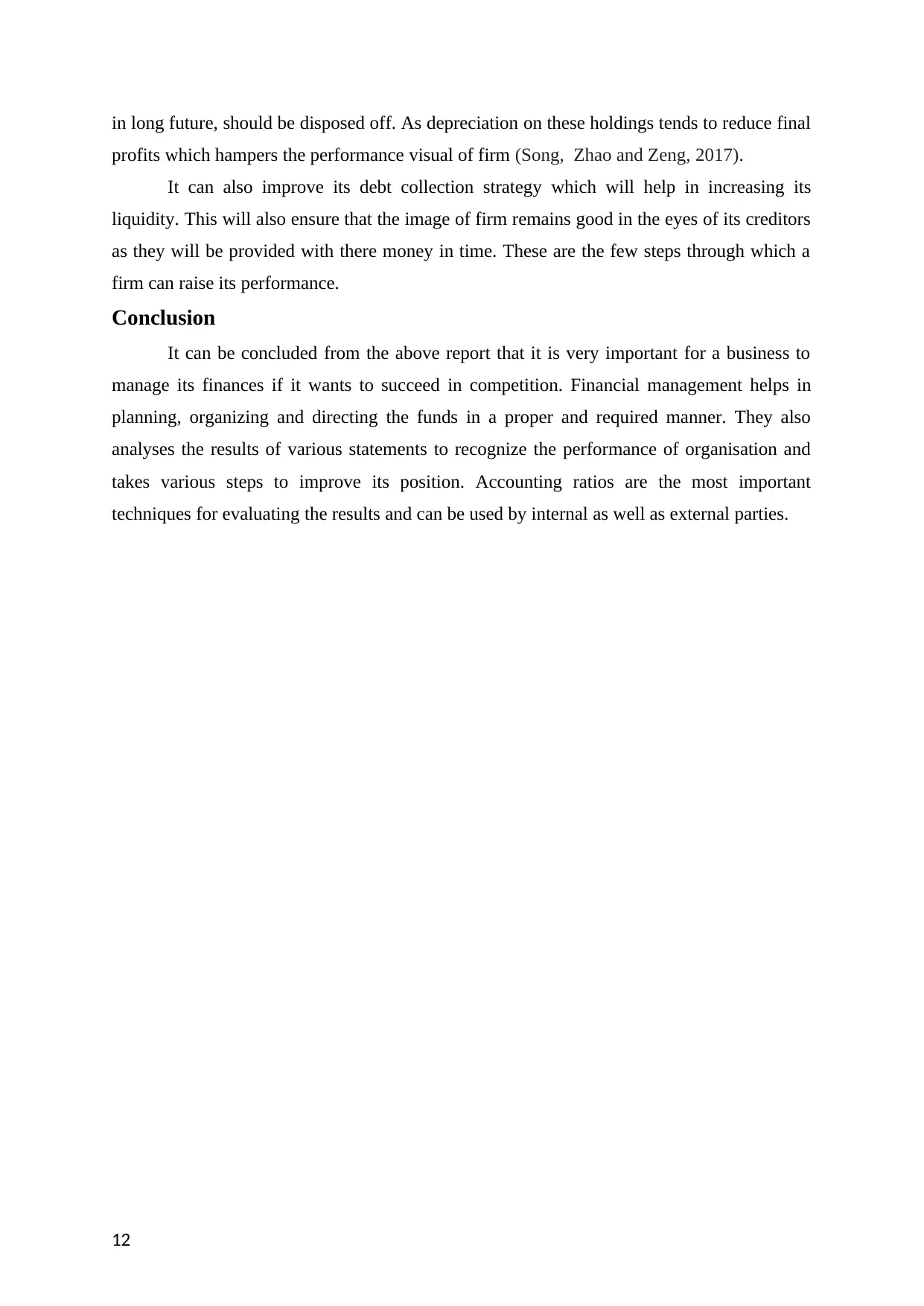
in long future, should be disposed off. As depreciation on these holdings tends to reduce final
profits which hampers the performance visual of firm (Song, Zhao and Zeng, 2017).
It can also improve its debt collection strategy which will help in increasing its
liquidity. This will also ensure that the image of firm remains good in the eyes of its creditors
as they will be provided with there money in time. These are the few steps through which a
firm can raise its performance.
Conclusion
It can be concluded from the above report that it is very important for a business to
manage its finances if it wants to succeed in competition. Financial management helps in
planning, organizing and directing the funds in a proper and required manner. They also
analyses the results of various statements to recognize the performance of organisation and
takes various steps to improve its position. Accounting ratios are the most important
techniques for evaluating the results and can be used by internal as well as external parties.
12
profits which hampers the performance visual of firm (Song, Zhao and Zeng, 2017).
It can also improve its debt collection strategy which will help in increasing its
liquidity. This will also ensure that the image of firm remains good in the eyes of its creditors
as they will be provided with there money in time. These are the few steps through which a
firm can raise its performance.
Conclusion
It can be concluded from the above report that it is very important for a business to
manage its finances if it wants to succeed in competition. Financial management helps in
planning, organizing and directing the funds in a proper and required manner. They also
analyses the results of various statements to recognize the performance of organisation and
takes various steps to improve its position. Accounting ratios are the most important
techniques for evaluating the results and can be used by internal as well as external parties.
12
⊘ This is a preview!⊘
Do you want full access?
Subscribe today to unlock all pages.

Trusted by 1+ million students worldwide
1 out of 14
Related Documents
Your All-in-One AI-Powered Toolkit for Academic Success.
+13062052269
info@desklib.com
Available 24*7 on WhatsApp / Email
![[object Object]](/_next/static/media/star-bottom.7253800d.svg)
Unlock your academic potential
Copyright © 2020–2025 A2Z Services. All Rights Reserved. Developed and managed by ZUCOL.


